| In this section we first examine the STC-OFDM system performance in correlated fading channels in terms of channel capacity and pairwise error probability (PEP). In [363], information- theoretic aspects of a two-ray propagation fading channel are studied. In [122, 478], the channel capacity of a multiple-antenna system in fading channels is investigated; and in [39], the limiting performance of a multiple-antenna system in block-fading channels is studied, under the assumption that the fading channels are uncorrelated and the channel state information is known to both the transmitter and the receiver. Here, we analyze the channel capacity of a multiple-antenna OFDM system over correlated frequency- and time-selective fading channels, assuming that the CSI is known only to the receiver. As a promising coding scheme to approach the channel capacity, STC is employed as the channel code in this system. The pairwise error probability analysis of the STC-OFDM system is also given. Moreover, based on the analysis of the channel capacity and the PEP, some STC design principles for the system under consideration are suggested. Since the STC based on state-of-the-art low-density parity-check (LDPC) codes [127, 302, 303, 416, 417] turns out to be a good candidate to meet these design principles, we then discuss an LDPC-based STC-OFDM system and a turbo receiver for this system. The materials in this section first appeared in [293]. Note that a simple space-time trellis code design method for OFDM systems is given in [289, 291]. 10.5.1 Capacity Considerations for STC-OFDM Systems System Model We consider an STC-OFDM system with Q subcarriers, N transmitter antennas, and M receiver antennas, signaling through frequency- and time-selective fading channels, as illustrated in Fig. 10.22. Each STC code word spans P adjacent OFDM words, and each OFDM word consists of ( NQ ) STC symbols, transmitted simultaneously during one time slot. Each STC symbol is transmitted on a particular OFDM subcarrier and a particular transmitter antenna. Figure 10.22. System description of a multiple-antenna STC-OFDM system over correlated fading channels. Each STC code word spans K subcarriers and P time slots in the system; on a particular subcarrier and in a particular time slot, STC symbols are transmitted from N transmitter antennas and received by M receiver antennas. 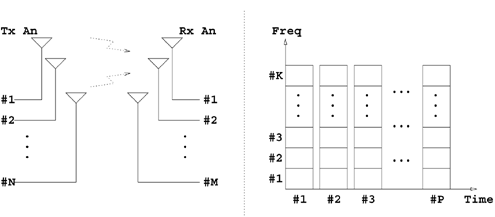 As in Section 10.4, it is assumed that the fading process remains static during each OFDM word (one time slot) but varies from one OFDM word to another; and the fading processes associated with different transmitter “receiver antenna pairs are uncorrelated. (However, as will be shown below, in a typical OFDM system, for a particular transmitter “receiver antenna pair, the fading processes are correlated in both frequency and time.) At the receiver, the signals are received from M receiver antennas. After matched filtering and sampling, the DFT is applied to the received discrete-time signal to obtain Equation 10.63 
where  is the matrix of complex channel frequency responses at the k th subcarrier and at the p th time slot, which is explained below; is the matrix of complex channel frequency responses at the k th subcarrier and at the p th time slot, which is explained below;  and and  are, respectively, the transmitted and received signals at the k th subcarrier and at the p th time slot; are, respectively, the transmitted and received signals at the k th subcarrier and at the p th time slot;  is the ambient noise, which is circularly symmetric complex Gaussian with unit variance. is the ambient noise, which is circularly symmetric complex Gaussian with unit variance. Consider the channel response between the j th transmitter antenna and the i th receiver antenna. As before, the time-domain channel impulse response can be modeled as a tapped-delay line. With only the nonzero taps considered , it can be expressed as Equation 10.64 
where d ( ·) is the Dirac delta function; L f denotes the number of nonzero taps; a i , j ( l ; t ) is the complex amplitude of the l th nonzero tap, whose delay is n l /( Q D f ), where n l is an integer and D f is the tone spacing of the OFDM system. In mobile channels, for the particular ( i , j )th antenna pair, the time-varying tap coefficients a i , j ( l ; t ) can be modeled as wide-sense stationary random processes with uncorrelated scattering (WSSUS) and with bandlimited Doppler power spectrum [396]. For the signal model in (10.63), we need only consider the time responses of a i , j ( l ; t ) within the time interval t  [0, PT ], where T is the total time duration of one OFDM word plus its cyclic extension and PT is the total time involved in transmitting P adjacent OFDM words. Following [568], for the particular l th tap of the ( i , j )th antenna pair, the dimension of the band - and time-limited random process a i , j ( l ; t ), t [0, PT ], where T is the total time duration of one OFDM word plus its cyclic extension and PT is the total time involved in transmitting P adjacent OFDM words. Following [568], for the particular l th tap of the ( i , j )th antenna pair, the dimension of the band - and time-limited random process a i , j ( l ; t ), t  [0, PT ] (defined as the number of significant eigenvalues in the Karhunen-Loeve expansion of this random process) is approximately equal to [0, PT ] (defined as the number of significant eigenvalues in the Karhunen-Loeve expansion of this random process) is approximately equal to  where f d is the maximum Doppler frequency. Hence, ignoring edge effects, the time response of a i , j ( l ; t ) can be expressed in terms of the Fourier expansion as where f d is the maximum Doppler frequency. Hence, ignoring edge effects, the time response of a i , j ( l ; t ) can be expressed in terms of the Fourier expansion as Equation 10.65 
where { b i,j ( l, n )} n is a set of independent circularly symmetric complex Gaussian random variables , indexed by n . For OFDM systems with proper cyclic extension and sample timing, with tolerable leakage, the channel frequency response between the j th transmitter antenna and the i th receiver antenna at the p th time slot and the k th subcarrier, which is exactly the ( i,j )th element of H [ p, k ] in (10.63), can be expressed as [506] Equation 10.66 
where  is the L f - sized vector containing the time responses of all the nonzero taps, and is the L f - sized vector containing the time responses of all the nonzero taps, and  contains the corresponding DFT coefficients. contains the corresponding DFT coefficients. Using (10.65), a i,j ( l; pT ) can be simplified to Equation 10.67 
where  is an L t -length vector and is an L t -length vector and  contains the corresponding inverse DFT coefficients. Substituting (10.67) into (10.66), we have contains the corresponding inverse DFT coefficients. Substituting (10.67) into (10.66), we have Equation 10.68 
with  From (10.68) it is seen that due to the close spacing of OFDM subcarriers and the limited Doppler frequency, for a specific antenna pair ( i,j ) the channel responses { H i,j [ p, k ]} p,k are different transformations [specified by w t ( p ) and w f ( k )] of the same random vector g i,j , and hence they are correlated in both frequency and time. Channel Capacity In this section we consider the channel capacity of the system described above. Assuming that the channel state information is known only at the receiver and the transmitter power is constrained as trace { E [ x [ p, k ] x H [ p, k ]]}  g , the instantaneous channel capacity of this system, which is defined as the mutual information conditioned on the correlated fading channel values g , the instantaneous channel capacity of this system, which is defined as the mutual information conditioned on the correlated fading channel values  , can be computed as [39, 363] , can be computed as [39, 363] Equation 10.69 
where  , and l i ( p, k ) is the i th nonzero eigenvalue of the nonnegative definite Hermitian matrix H [ p, k ] H H [ p, k ]. The maximization of , and l i ( p, k ) is the i th nonzero eigenvalue of the nonnegative definite Hermitian matrix H [ p, k ] H H [ p, k ]. The maximization of  is achieved when { x [ p, k ]} p,k consists of independent circularly symmetric complex Gaussian random variables with identical variances [39, 363]. (When the CSI is known to both the transmitter and the receiver, the instantaneous channel capacity is maximized by "water filling" [40].) The ergodic channel capacity is defined as is achieved when { x [ p, k ]} p,k consists of independent circularly symmetric complex Gaussian random variables with identical variances [39, 363]. (When the CSI is known to both the transmitter and the receiver, the instantaneous channel capacity is maximized by "water filling" [40].) The ergodic channel capacity is defined as  . In the system considered, the concept of ergodic channel capacity I ( g ) is of less interest, because the fading processes are not ergodic, due to the limited number of antennas and the limited L f and L t . . In the system considered, the concept of ergodic channel capacity I ( g ) is of less interest, because the fading processes are not ergodic, due to the limited number of antennas and the limited L f and L t . Since  is a random variable, whose statistics are determined jointly by ( g , N, M ) and the characteristics of correlated fading channels, we turn to another important concept ” outage capacity , which is closely related to the code word error probability, as averaged over the random coding ensemble and over all channel realizations [39]. The outage probability is defined as the probability that the channel cannot support a given information rate R , is a random variable, whose statistics are determined jointly by ( g , N, M ) and the characteristics of correlated fading channels, we turn to another important concept ” outage capacity , which is closely related to the code word error probability, as averaged over the random coding ensemble and over all channel realizations [39]. The outage probability is defined as the probability that the channel cannot support a given information rate R , Equation 10.70 
Since it is difficult to get an analytical expression for (10.70), we resort to Monte Carlo integration for its numerical evaluation. In the following, we give some numerical results of the outage probability in (10.70) obtained by Monte Carlo integration. For simplicity, we assume that all elements in { g i,j } i,j have the same variance. Define the selective-fading diversity order L as the product of the number of nonzero delay taps L f and the dimension of Doppler fading process  . The following observations can be made from the numerical evaluations of (10.70). . The following observations can be made from the numerical evaluations of (10.70). -
From Figs. 10.23 and 10.24, it is seen that at a practical outage probability (e.g., P out = 1%), for fixed ( N, M , g ) the highest achievable information rate increases as the selective-fading diversity order L increases, but the increase diminishes as L becomes larger. Eventually, as L   , the highest achievable information rate converges to the ergodic capacity. [Note that the ergodic capacity is the area above each curve in the figure: , the highest achievable information rate converges to the ergodic capacity. [Note that the ergodic capacity is the area above each curve in the figure:  Figure 10.23. Outage probability versus information rate in a correlated fading OFDM system with M = 1, Q = 256, P = 1, SNR = 20 dB, where dashed lines represent a system with one transmitter antenna ( N = 1) and solid lines represent a system with four transmitter antennas ( N = 4). The vertical dash- dotted line represents the AWGN channel capacity (when SNR = 20 dB). The fading channels are frequency- and time-nonselective with L t = 1, L = L f = {1, 2, 3, 6}.  Figure 10.24. Outage probability versus information rate in a correlated fading OFDM system with N = 2, M = 1, Q = 256, P = 10, SNR = 20 dB. Dashed lines represent frequency-selective and time-nonselective channels with L t = 1, L = L f = {2, 6, 10}. Dotted lines represent frequency- and time-selective channels with L f = 2, L = 2 L t = {2, 6, 10}. Note that for the same L , the dashed and dotted lines overlap, which shows the equivalent impacts of frequency- and time-selective fading on the outage probability. 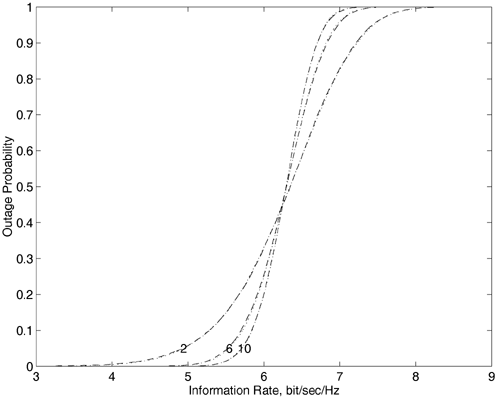 -
Figure 10.24 compares the effects of the frequency-selectivity order L f and the time-selectivity order L t on the outage capacity. It shows that the frequency and time selectivity are essentially equivalent in terms of their effects on the outage capacity. In other words, the selective-fading diversity order L = L f L t ultimately affects the outage capacity. -
From Fig. 10.23 it is seen that as the area above each curve, the ergodic channel capacity is invariant to the selective-fading diversity order L (which is the key parameter in determining the correlation characteristics of the fading channels) and it is determined only by the spatial diversity order ( N, M ) and the transmitted signal power g [122, 478]. Moreover, it is seen that both the outage and ergodic capacities can be increased by fixing the number of receiver antennas and increasing the number of transmitter antennas (or vice versa) (e.g., by fixing M = 1 and letting N   , the ergodic capacity converges to the capacity of AWGN channels [353]). , the ergodic capacity converges to the capacity of AWGN channels [353]). In summary, we have seen the different effects of two diversity resources, spatial diversity and selective-fading diversity, on the channel capacity of a multiple-antenna correlated fading OFDM system. Increasing the spatial diversity order (i.e., N, M ) can always bring capacity (outage capacity and/or ergodic capacity) increase at the expense of extra physical costs. By contrast, the selective-fading diversity is a free resource, but its effect on improving the channel capacity becomes less as L becomes larger. Since both diversity resources can improve the capacity of a multiple-antenna OFDM system, it is crucial to have an efficient channel coding scheme, which can take advantage of all available diversity resources of the system. Pairwise Error Probability To obtain further insight into coding design, it is of interest to analyze the pairwise error probability of this system with coded modulation. With perfect CSI at the receiver, the maximum likelihood decision rule for the signal model (10.63) is given by Equation 10.71 
where the minimization is over all possible STC code words  . Assuming equal transmitted power at all transmitter antennas, using the Chernoff bound [396], the PEP of transmitting x and deciding in favor of another code word . Assuming equal transmitted power at all transmitter antennas, using the Chernoff bound [396], the PEP of transmitting x and deciding in favor of another code word  at the decoder is upper bounded by at the decoder is upper bounded by Equation 10.72 
where g is the total signal power transmitted from all N transmitted antennas. (Recall that the noise at each receiver antenna is assumed to have unit variance.) Using (10.66)-(10.68),  is given by is given by Equation 10.73 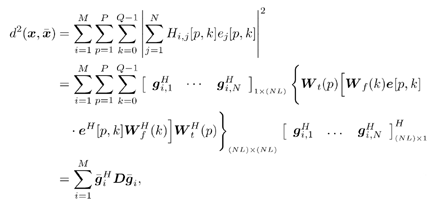
with Equation 10.74 
Equation 10.75 
In (10.74),  is a rank-one matrix, which is equal to a zero matrix if the entries of code words x and is a rank-one matrix, which is equal to a zero matrix if the entries of code words x and  corresponding to the k th subcarrier and p th time slot are the same. Let D denote the number of instances when corresponding to the k th subcarrier and p th time slot are the same. Let D denote the number of instances when  ; similar to [438], D eff , which is the minimum D over every two possible code word pair, is called the effective length of the code. Denote ; similar to [438], D eff , which is the minimum D over every two possible code word pair, is called the effective length of the code. Denote  ; it is easily seen that ; it is easily seen that  . Since w f ( k ) and w t ( p ) vary with different multipath delay profiles and Doppler power spectrum shapes , the matrix D also varies with different channel environments. However, since D is a nonnegative definite Hermitian matrix, by an eigendecomposition, it can be written as . Since w f ( k ) and w t ( p ) vary with different multipath delay profiles and Doppler power spectrum shapes , the matrix D also varies with different channel environments. However, since D is a nonnegative definite Hermitian matrix, by an eigendecomposition, it can be written as Equation 10.76 
where V is a unitary matrix and  , with , with  being the positive eigenvalues of D . Moreover, by assumption, all the ( N M L ) elements of { g i,j } i,j are i.i.d. circularly symmetric complex Gaussian with zero means. So (10.72) can be rewritten as being the positive eigenvalues of D . Moreover, by assumption, all the ( N M L ) elements of { g i,j } i,j are i.i.d. circularly symmetric complex Gaussian with zero means. So (10.72) can be rewritten as Equation 10.77 
where  is the j th element of is the j th element of  . Since V is unitary, . Since V is unitary,  are also i.i.d. circularly symmetric complex Gaussian with zero means, and their magnitudes are also i.i.d. circularly symmetric complex Gaussian with zero means, and their magnitudes  are i.i.d. Rayleigh distributed. By averaging the conditional PEP in (10.77) over the Rayleigh pdf (probability density function), the PEP bound for a multiple-antenna STC-OFDM system over correlated fading channels can finally be written as are i.i.d. Rayleigh distributed. By averaging the conditional PEP in (10.77) over the Rayleigh pdf (probability density function), the PEP bound for a multiple-antenna STC-OFDM system over correlated fading channels can finally be written as Equation 10.78 
It is seen from (10.78) that the highest possible diversity order the STC-OFDM system can provide is N M L : the product of the number of transmitter antennas, the number of receiver antennas, and the selective-fading diversity order of the channels. In other words, the attractiveness of the STC-OFDM system lies in its ability to exploit all the available diversity resources. However, note that although in the analysis of PEP the three parameters ( N, M, L ) appear equivalent in improving the system performance, they actually play different roles from the capacity viewpoint, as indicated above. 10.5.2 Low-Density Parity-Check Codes First proposed by Gallager in 1962 [127] and reexamined in [302, 303, 416, 417], low-density parity-check codes have been shown to be a very promising coding technique for approaching the channel capacity in AWGN channels. For example, a carefully constructed rate- ½ irregular LDPC code with long block length has a bit-error probability of 10 -6 just 0.04 dB away from the Shannon capacity of AWGN channels [82]. As the name suggests, an LDPC code is a linear block code specified by a very sparse parity-check matrix as illustrated in Fig. 10.25. The parity-check matrix H of a regular ( N, K, s, t ) LDPC code of rate R = K/N is an ( N - K ) x N matrix, which has s 1s in each column and t > s 1s in each row where s << N . Apart from these constraints, the 1s are typically placed at random in the parity-check matrix. When the number of 1s in every column is not the same, the code is known as an irregular LDPC code. It should be noted that the parity-check matrix is not constructed in systematic form. Consequently, to obtain the generator matrix G , we first apply Gaussian elimination to reduce the parity-check matrix to a form H = [ I N “K P T ], where I N “K is an ( N “ K ) x ( N “ K ) identity matrix. Then the generator matrix is given by G = [ P I K ]. In contrast to P , the generator matrix G is dense. Consequently, the number of bit operations required to encode is  , which is larger than that for other linear codes. Similar to turbo codes, LDPC codes can be efficiently decoded by a suboptimal iterative belief propagation algorithm, which is explained in detail in [127]. At the end of each iteration, the parity check is performed. If the parity check is correct, the decoding is terminated ; otherwise , the decoding continues until it reaches the maximum number of iterations (e.g., 30). , which is larger than that for other linear codes. Similar to turbo codes, LDPC codes can be efficiently decoded by a suboptimal iterative belief propagation algorithm, which is explained in detail in [127]. At the end of each iteration, the parity check is performed. If the parity check is correct, the decoding is terminated ; otherwise , the decoding continues until it reaches the maximum number of iterations (e.g., 30). Figure 10.25. Example of a parity-check matrix P for an ( n, k, t, j ) = (20, 5, 3, 4) regular LDPC code with code rate-  , block length n = 20, column weight t = 3, and row weight j = 4. , block length n = 20, column weight t = 3, and row weight j = 4. 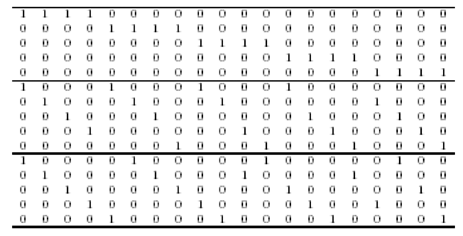 The code with parity-check matrix H can be represented by a bipartite graph which consists of two types of nodes, variable nodes and check nodes. Each code bit is a variable node, while each parity check or each row of the parity-check matrix represents a check node. An edge in the graph is placed between variable node i and check node j if H j,i = 1. That is, each check node is connected to code bits whose sum modulo-2 should be zero. Irregular LDPC codes are specified by two polynomials  and and  , where l i is the fraction of edges in the bipartite graph that are connected to variable nodes of degree i , and p i is the fraction of edges that are connected to check nodes of degree i . Equivalently, the degree profiles can also be specified from the node perspective: two polynomials , where l i is the fraction of edges in the bipartite graph that are connected to variable nodes of degree i , and p i is the fraction of edges that are connected to check nodes of degree i . Equivalently, the degree profiles can also be specified from the node perspective: two polynomials  and and  where where  is the fraction of variable nodes of degree i and is the fraction of variable nodes of degree i and  is the fraction of check nodes of degree i . The parity-check matrix for an irregular (7, 4) code and its associated bipartite graph is shown in Fig. 10.26 as an example. The degree profiles for this code from the edge perspective are l ( x ) = 1/4 + ½ x + ½ x 2 and r ( x ) = x 3 . The degree profiles from the node perspective are is the fraction of check nodes of degree i . The parity-check matrix for an irregular (7, 4) code and its associated bipartite graph is shown in Fig. 10.26 as an example. The degree profiles for this code from the edge perspective are l ( x ) = 1/4 + ½ x + ½ x 2 and r ( x ) = x 3 . The degree profiles from the node perspective are  and and  Figure 10.26. Bipartite graph representing parity-check and bit nodes of an irregular LDPC code.  Before we discuss the LDPC decoding algorithm, we first establish the following notation. All extrinsic messages (information) are in log-likelihood form, and the variable L is used to refer to extrinsic messages. Superscript p is used to denote quantities during the p th iteration of LDPC decoding. A subscript b  c or b c or b  c denotes quantities passed between the bit nodes and the check nodes of the LDPC code. The variable (bit) nodes in the bipartite graph of the LDPC code are numbered from 1 to N and the check nodes from 1 to N “ K (in any order). The degree of the i th bit node is denoted by c denotes quantities passed between the bit nodes and the check nodes of the LDPC code. The variable (bit) nodes in the bipartite graph of the LDPC code are numbered from 1 to N and the check nodes from 1 to N “ K (in any order). The degree of the i th bit node is denoted by  and the degree of the i th check node is denoted by D i . Denote by and the degree of the i th check node is denoted by D i . Denote by  the set of edges connected to the i th bit node and by the set of edges connected to the i th bit node and by  the set of edges connected to the i th check node. That is, the set of edges connected to the i th check node. That is,  denotes the k th edge connected to the i th bit node, and denotes the k th edge connected to the i th bit node, and  denotes the k th edge connected to the i th check node. The particular edge or bit associated with a piece of extrinsic information is denoted as the argument of L . For example, denotes the k th edge connected to the i th check node. The particular edge or bit associated with a piece of extrinsic information is denoted as the argument of L . For example,  denotes the extrinsic LLR passed from a bit node to a check node along the j th edge connected to the i th bit node, during the p th iteration within the LDPC decoder. denotes the extrinsic LLR passed from a bit node to a check node along the j th edge connected to the i th bit node, during the p th iteration within the LDPC decoder. The LDPC decoding algorithm is summarized as follows . Algorithm 10.4: [LDPC decoding algorithm] Initially, all extrinsic messages are assumed to be zeros  Equation 10.79 
-
- Check node update: For each of the check nodes i = 1, 2, ..., N “ K , for all edges that are connected to the check node, compute the extrinsic message passed from the check node to the bit node, given by Equation 10.80 
Equation 10.81 
10.5.3 LDPC-Based STC-OFDM System In this section, we consider coding design for STC-OFDM systems. We assume that the CSI is known only at the receiver. Coding Design Principles The capacity and PEP analyses of a general STC-OFDM system shed some light on the STC coding design problem: -
The dominant exponent in the PEP (10.78) that is related to the structure of the code is r , the rank of the matrix D . Recall that  ; to achieve the maximum diversity ( N M L ), it is necessary that D eff ; to achieve the maximum diversity ( N M L ), it is necessary that D eff  N L [i.e., the effective length of the code must be larger than the dimension of matrix D in (10.74)]. Since L is associated with the channel characteristic, which is not know to the transmitter (or the STC encoder) in advance, it is preferable to have an STC code with large effective length. N L [i.e., the effective length of the code must be larger than the dimension of matrix D in (10.74)]. Since L is associated with the channel characteristic, which is not know to the transmitter (or the STC encoder) in advance, it is preferable to have an STC code with large effective length. -
Another factor in the PEP is  the product of eigenvalues of matrix D . Since D changes with different channel setup, the optimal design of the product of eigenvalues of matrix D . Since D changes with different channel setup, the optimal design of  is not feasible . However, as observed in [477], the space-time trellis codes (STTCs) with higher state numbers (and essentially larger effective length) have better performance, which suggests that increasing the effective length of the STC beyond the minimum requirement (e.g., N L in our system) may help to improve the factor is not feasible . However, as observed in [477], the space-time trellis codes (STTCs) with higher state numbers (and essentially larger effective length) have better performance, which suggests that increasing the effective length of the STC beyond the minimum requirement (e.g., N L in our system) may help to improve the factor  -
Also, as seen from (10.69), to achieve the channel capacity, all the N K P transmitted STC symbols are required to be independent. Therefore, after introducing the coding constraints to the coded symbols, an interleaver is needed to scramble the coded symbols in order to satisfy the independence condition. From the standpoint of PEP analysis, such an interleaver helps to improve the factor  as well. as well. In summary, in the system considered here, because of the diverse fading profiles of the wireless channels and the assumption that the CSI is known only at the receiver, the systematic coding design (e.g., by computer search) is less helpful; instead, two general principles should be met in choosing STC codes in order to robustly exploit the rich diversity resources in this system, namely, large effective length and ideal interleaving . Space-time trellis codes have been proposed for multiple-antenna systems over flat-fading channels [477]. However, the complexity of the STTC increases dramatically as the effective length increase, and therefore it may not be a good candidate for the OFDM system considered here. Another family of STCs comprises the turbo- code-based STCs [281, 459], but their decoding complexity is high and they are not flexible in terms of scalability (e.g., when employed in systems with different requirements of the information rate). Here, we consider an alternative STC scheme ”LDPC-based STC [293]. LDPC-Based STC The LDPC codes have the following advantages for the STC-OFDM system considered here: (1) The LDPC decoder usually has a lower computational complexity than the turbo-code decoder. In addition to this, since the decoding complexity of each iteration in an LDPC decoder is much less than a turbo-code decoder, a finer resolution in the performance-complexity trade-off can be obtained by varying the maximum number of iterations. Moreover, the decoding of LDPC is highly parallelizable. (2) The minimum distance of binary LDPC codes increases linearly with the block length with probability close to 1 [127]. (3) It is easier to design a competitive LDPC code with any block length and any code rate, which makes it easier for the LDPC-based STC to scale according to different system requirements (e.g., different numbers of antennas or different information rates). (4) LDPC codes do not typically show an error floor, which is suitable for short-frame applications. (5) Due to the random generation of the parity-check matrix (or equivalently, the encoder matrix), the coded bits have been effectively interleaved; therefore, no extra interleaver is needed. The transmitter structure of an LDPC-based STC-OFDM system is illustrated in Fig. 10.27. Denote by W the set of all possible STC symbols, which is up to a constant  of the traditional constellation (e.g., MPSK or QAM). (Recall that the additive noise is assumed to have unit variance.) The P K log 2 W information bits are first encoded by a rate R = 1/ N LDPC encoder into N P K log 2 W coded bits, and then the binary LDPC coded bits are modulated into N P K STC symbols by an MPSK (or QAM) modulator . These N P K STC symbols, which correspond to an STC code word, are split into N streams; the P K STC symbols of each stream are transmitted from one particular transmitter antenna at K subcarriers and over P adjacent OFDM slots. Note that in the bit-interleaved coded-modulation system proposed above, the built-in random interleaver of the LDPC codes is also helpful to minimize loss in the effective length between the binary LDPC code bits and the modulated STC code symbols, which is caused by the MPSK (or QAM) modulation. of the traditional constellation (e.g., MPSK or QAM). (Recall that the additive noise is assumed to have unit variance.) The P K log 2 W information bits are first encoded by a rate R = 1/ N LDPC encoder into N P K log 2 W coded bits, and then the binary LDPC coded bits are modulated into N P K STC symbols by an MPSK (or QAM) modulator . These N P K STC symbols, which correspond to an STC code word, are split into N streams; the P K STC symbols of each stream are transmitted from one particular transmitter antenna at K subcarriers and over P adjacent OFDM slots. Note that in the bit-interleaved coded-modulation system proposed above, the built-in random interleaver of the LDPC codes is also helpful to minimize loss in the effective length between the binary LDPC code bits and the modulated STC code symbols, which is caused by the MPSK (or QAM) modulation. Figure 10.27. Transmitter structure of an LDPC-based STC-OFDM system with multiple antennas.  As an example, consider a regular binary LDPC code with column weight t = 3, rate R =  , and block length n = 1024, in which case the minimum distance is around 100 [127]. The STC based on this LDPC code is configured with a QPSK modulator and two transmitter antennas; therefore, the effective length of this LDPC-based STC is at least 25, which is more than enough to satisfy the minimum effective length requirement for a two-transmitter antenna ( N = 2) OFDM system in a six-tap ( L = 6) frequency-selective fading channel. Together with its built-in random interleaver, this LDPC code can well satisfy the two coding design principles mentioned earlier and therefore is an empirically good STC for the OFDM system considered in this chapter. Since the minimum distance of binary LDPC codes increase linearly with the block length, further performance improvement is possible by increasing the block length. Note that we do not claim the optimality of the proposed LDPC-based STC; but rather, we argue that with its low decoding complexity, flexible scalability, and high performance, the LDPC-based STC is a promising coding technique for reliable high-speed data communication in multiple-antenna OFDM systems with frequency- and time-selective fading. , and block length n = 1024, in which case the minimum distance is around 100 [127]. The STC based on this LDPC code is configured with a QPSK modulator and two transmitter antennas; therefore, the effective length of this LDPC-based STC is at least 25, which is more than enough to satisfy the minimum effective length requirement for a two-transmitter antenna ( N = 2) OFDM system in a six-tap ( L = 6) frequency-selective fading channel. Together with its built-in random interleaver, this LDPC code can well satisfy the two coding design principles mentioned earlier and therefore is an empirically good STC for the OFDM system considered in this chapter. Since the minimum distance of binary LDPC codes increase linearly with the block length, further performance improvement is possible by increasing the block length. Note that we do not claim the optimality of the proposed LDPC-based STC; but rather, we argue that with its low decoding complexity, flexible scalability, and high performance, the LDPC-based STC is a promising coding technique for reliable high-speed data communication in multiple-antenna OFDM systems with frequency- and time-selective fading. As in a typical data communication scenario, communication is carried out in a bursty manner. A data burst is illustrated in Fig. 10.13. It spans ( P q + 1) OFDM words, with the first OFDM word containing known pilot symbols. The remaining P q OFDM words contain q STC code words. 10.5.4 Turbo Receiver We next consider receiver design for the proposed LDPC-based STC-OFDM system. Even with ideal CSI, the optimal decoding algorithm for this system has exponential complexity. Hence we apply the turbo receiver structure. As a standard procedure, to demodulate each STC code word, the turbo receiver consists of two stages, the soft demodulator and the soft LDPC decoder , and the extrinsic information is iteratively exchanged between these two stages to successively improve the receiver performance. However, in practice, the channel state information must be estimated by the receiver. In the following we discuss a turbo receiver for unknown fast-fading channels based on the MAP-EM algorithm. The turbo receiver for the LDPC-based STC-OFDM system is illustrated in Fig. 10.28. It consists of a soft maximum a posteriori expectation-maximization (MAP-EM) demodulator and a soft LDPC decoder, both of which are iterative devices themselves . The soft MAP-EM demodulator takes as input the FFT of the received signals from M receiver antennas, and the extrinsic log-likelihood ratios of the LDPC coded bits { l 2 } [cf. (10.62)] (which are fed back by the soft LDPC decoder). It computes as output the extrinsic a posteriori LLRs of the LDPC coded bits  [cf. (10.62)]. (As an important issue in the EM algorithm, the initialization of the MAP-EM demodulator will be discussed later in this section.) The soft LDPC decoder takes as input the LLRs of the LDPC coded bits from the MAP-EM demodulator and computes as output the extrinsic LLRs of the LDPC coded bits as well as the hard decisions of the information bits at the last turbo iteration. It is assumed that the q STC words in a data burst are encoded independently. Therefore, each STC word (consisting of P OFDM words) is decoded independently by turbo processing. We next describe each component of the receiver shown in Fig. 10.28. [cf. (10.62)]. (As an important issue in the EM algorithm, the initialization of the MAP-EM demodulator will be discussed later in this section.) The soft LDPC decoder takes as input the LLRs of the LDPC coded bits from the MAP-EM demodulator and computes as output the extrinsic LLRs of the LDPC coded bits as well as the hard decisions of the information bits at the last turbo iteration. It is assumed that the q STC words in a data burst are encoded independently. Therefore, each STC word (consisting of P OFDM words) is decoded independently by turbo processing. We next describe each component of the receiver shown in Fig. 10.28. Figure 10.28. Turbo receiver structure which employs a MAP-EM demodulator and a soft LDPC decoder for multiple-antenna LDPC-based STC-OFDM systems in unknown fading channels. 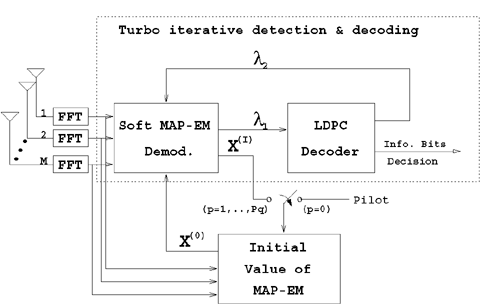 MAP-EM Demodulator Here we apply the MAP-EM algorithm discussed in Section 10.4.3. For notational simplicity, here we consider an LDPC-based STC-OFDM system with two transmitter antennas and one receiver antenna. The results can easily be extended to a system with N transmitter antennas and M receiver antennas. Note that for the purpose of performance analysis, the h i,j ( p ) defined in (10.66) contains only the time responses of L f nonzero taps; whereas for the purpose of receiver design, especially when channel state information (CSI) is not available, the h i,j ( p ) needs to be redefined to contain the time responses of all the taps within the maximum multipath spread. That is,  , with , with  and t m being the maximum multipath spread; and w f (k) is correspondingly redefined as and t m being the maximum multipath spread; and w f (k) is correspondingly redefined as  . The received signal during one data burst can be written as . The received signal during one data burst can be written as Equation 10.82 
with 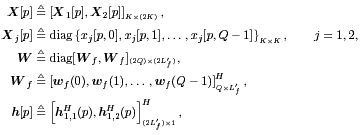
where y [ p ] and z [ p ] are Q -sized vectors which contain, respectively, the received signals and the ambient Gaussian noise at all Q subcarriers and at the p th time slot; the diagonal elements of X j [ p ] are the Q STC symbols transmitted from the j th transmitter antenna and at the p th time slot. Without CSI, the MAP detection problem is written as, Equation 10.83 
(Recall that X [0] contains pilot symbols.) As in Section 10.4, we use the EM algorithm to solve (10.83). In the E-step, the expectation is taken with respect to the "hidden" channel response h conditioned on y and X ( i ) . It is easily seen that conditioned on y and X ( i ) , h has a complex Gaussian distribution given by Equation 10.84 
with  where S z and S h denote, respectively, the covariance matrix of the ambient white Gaussian noise z and channel response h . As before, by assumption, both of them are diagonal matrices as  and and  , where , where  is the average power of the l th tap related with the j th transmitter antenna; is the average power of the l th tap related with the j th transmitter antenna;  if the channel response at this tap is zero. Assuming that S h is known (e.g., measured with the aid of pilot symbols), if the channel response at this tap is zero. Assuming that S h is known (e.g., measured with the aid of pilot symbols),  is defined as the pseudo-inverse of S h as is defined as the pseudo-inverse of S h as Equation 10.85 
Using (10.82) and (10.84), Q ( X X ( i ) ) is computed as Equation 10.86 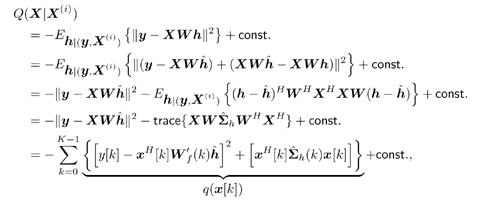
with  where  denotes the ( i,j )th element of the matrix denotes the ( i,j )th element of the matrix  . . Next, based on (10.86), the M-step proceeds as follows: Equation 10.87 
 or Equation 10.88 
where (10.87) follows from the assumption that X contains independent symbols. It is seen from (10.88) that the M-step can be decoupled into Q independent minimization problems, each of which can be solved by enumeration over all possible x  W x W . (Recall that W denotes the set of all STC symbols.) Hence the total complexity of the maximization step is W x W . (Recall that W denotes the set of all STC symbols.) Hence the total complexity of the maximization step is  . . Within each turbo iteration, the E-step and M-step above are iterated I times. At the end of the I th EM iteration, the extrinsic a posteriori LLRs of the LDPC code bits are computed and then fed to the soft LDPC decoder. At each OFDM subcarrier, two transmitter antennas transmit two STC symbols, which correspond to 2 log 2 W LDPC code bits. Based on (10.88), after I EM iterations, the extrinsic a posteriori LLR of the j th ( j = 1, ..., 2 log 2 W ) LDPC code bit at the k th subcarrier d j [k] is computed at the output of the MAP-EM demodulator as follows: Equation 10.89 
where  is the set of x for which the j th LDPC coded bit is "+1" and is the set of x for which the j th LDPC coded bit is "+1" and  is defined similarly. The extrinsic a priori LLRs { l 2 ( d j [ k ])} j,k are provided by the soft LDPC decoder at the previous turbo iteration. Finally, the extrinsic a posteriori LLRs { l 1 ( d j [ k ])} j,k are sent to the soft LDPC decoder, which in turn iteratively computes the extrinsic LLRs { l 2 ( d j [ k ])} j,k and then feeds them back to the MAP-EM demodulator and thus completes one turbo iteration. At the end of the last turbo iteration, hard decisions of the information bits are output by the LDPC decoder. is defined similarly. The extrinsic a priori LLRs { l 2 ( d j [ k ])} j,k are provided by the soft LDPC decoder at the previous turbo iteration. Finally, the extrinsic a posteriori LLRs { l 1 ( d j [ k ])} j,k are sent to the soft LDPC decoder, which in turn iteratively computes the extrinsic LLRs { l 2 ( d j [ k ])} j,k and then feeds them back to the MAP-EM demodulator and thus completes one turbo iteration. At the end of the last turbo iteration, hard decisions of the information bits are output by the LDPC decoder. Initialization of MAP-EM Demodulator The performance of the MAP-EM demodulator (and hence the overall receiver) is closely related to the quality of the initial value of X (0) [ p ] [cf. (10.44)]. At each turbo iteration, X (0) [ p ] needs to be specified to initialize the MAP-EM demodulator. Except for the first turbo iteration, X (0) [ p ] is simply taken as X ( I ) [ p ] given by (10.87) from the previous turbo iteration. We next discuss the procedure for computing X (0) [ p ] at the first turbo iteration. The initial estimate of X (0) [ p ] is based on the method proposed in [260, 263], which makes use of pilot symbols and decision feedback as well as spatial and temporal filtering for channel estimates. The procedure is listed in Table 10.2, where Freq-filter denotes either the least-squares estimator (LSE) or the MMSE estimator as Equation 10.90 
where X represents either the pilot symbols or X ( I ) provided by the MAP-EM demodulator. Comparing these two estimators, the LSE does not need any statistical information of h , but the MMSE offers better performance in terms of mean-square error (MSE). Hence, in the pilot slot, the LSE is used to estimate channels and to measure S h ; and in the remaining data slots, the MMSE is used. In Table 10.2, Temp-filter denotes the temporal filter, which is used to further exploit the time-domain correlation of the channel: Equation 10.91 
where  , is computed from (**) (cf. Table 10.1); , is computed from (**) (cf. Table 10.1);  denotes the coefficients of an I -length ( I denotes the coefficients of an I -length ( I  Pq ) temporal filter, which can be obtained by solving the Wiener equation or from robust design as in [260, 263]. From the discussion above, it is seen that the computation involved in initializing X (0) [ p ] consists mainly of the ML detection of X (0) [ p ] in (*) and the estimation of Pq ) temporal filter, which can be obtained by solving the Wiener equation or from robust design as in [260, 263]. From the discussion above, it is seen that the computation involved in initializing X (0) [ p ] consists mainly of the ML detection of X (0) [ p ] in (*) and the estimation of  in (**). In general, for an STC-OFDM system with parameters in (**). In general, for an STC-OFDM system with parameters  , the total complexity in initializing X (0) [ p ] is , the total complexity in initializing X (0) [ p ] is  . . Simulation Examples In this section we provide simulation results to illustrate the performance of the proposed LDPC-based STC-OFDM system in frequency- and time-selective fading channels. The correlated fading processes are generated by using the methods in [180]. In the following simulations the available bandwidth is 1 MHz and is divided into 256 subcarriers. These correspond to a subcarrier symbol rate of 3.9 kHz and OFDM word duration of 256 m s. In each OFDM word, a guard interval of 40 m s is added to combat the effect of intersymbol interference; hence T = 296 m s. For all simulations, 512 information bits are transmitted from 256 subcarriers at each OFDM slot, and therefore the information rate is 2 x 256/296 = 1.73 bits/s per hertz. Unless otherwise specified, all the LDPC codes used in simulations are regular LDPC codes with column weight t = 3 in the parity-check matrices and with appropriate block lengths and code rates. The modulator uses the QPSK constellation. Simulation results are shown in terms of the OFDM word-error rate (WER) versus the SNR g . Table 10.2. Procedure for Computing X ( ) [ p ] for the MAP-EM Demodulator (at the First Turbo Iteration) |  | Performance with Ideal CSI Figures 10.29 and 10.30 show the performance of multiple-antenna ( N transmitter antennas and one receiver antenna) LDPC-based STC-OFDM systems by using turbo detection and decoding with ideal CSI. Performance is compared for systems with different fading profiles and different numbers of transmitter antennas. Namely, Ch1 denotes a channel with a single tap at 0 m s, Ch2a denotes a channel with two equal-power taps at 0 and 5 m s, Ch2b denotes a channel with two equal-power taps at 0 and 40 m s, and Ch6a denotes a channel with six equal-power taps equally spaced from 0 to 40 m s. Suffix N2 denotes a system with two transmitter antennas ( N = 2), and similarly for N3 ; suffix P1 denotes that each STC code word spans one OFDM slot ( P = 1), and similarly for P5 and P10 . Unless otherwise specified, all the STC-OFDM systems are assumed to use two transmitter antennas ( N = 2) and each STC code word spans one OFDM slot ( P = 1). First, Fig. 10.29 shows the performance of the LDPC-based STC-OFDM system in frequency- and time-nonselective channels. The dash-dotted curves represent the performance after the first turbo iteration; and the solid curves represent the performance after the fifth iteration. It is seen that the receiver performance is improved significantly through turbo iteration. During each turbo iteration, in the LDPC decoder, the maximum number of iterations is 30; and as observed in simulations, the average number of iterations needed in LDPC decoding is less than 10 when WER is less than 10 -2 . Compared with the conventional trellis-based STC-OFDM system (see figures in [8]), the LDPC-based STC-OFDM system improves performance significantly (e.g., there is around a 5-dB performance improvement in Ch2a / Ch2b channels and even more improvement in Ch6a channels). Moreover, due to the inherent interleaving in the LDPC encoder, the proposed LDPC-based STC narrows the performance difference between Ch2a and Ch2b channels (essentially the outage capacity of these two channels are the same). As the selective-fading diversity order L increases from Ch1 to Ch6a , LDPC-based STC can efficiently take advantage of the available diversity resources and hence can significantly improve the system performance. Moreover, in a highly frequency-selective channel, Ch6a , the LDPC-based STC performs only 3.0 dB away from the outage capacity of this channel (at a high information rate, 1.73 bits/s per hertz) at WER of 2 x 10 -4 . Figure 10.29. Word-error rate of an LDPC-based STC-OFDM system with multiple antennas ( N = {2,3}, M = 1) in frequency- and time-nonselective fading channels, with ideal CSI. 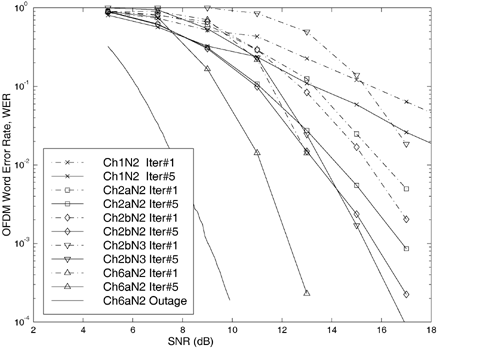 Next, Fig. 10.30 shows the performance of the LDPC-based STC-OFDM system in frequency- and time-selective fading channels. The maximum Doppler frequency is 200 Hz (i.e., the normalized Doppler frequency is f d T = 0.059). Again, it is seen that the performance of the system improves as the selective-fading diversity order L (including both frequency and time selectivities) increases. Figure 10.30. Word-error rate of an LDPC-based STC-OFDM system with multiple antennas ( N = 2, M = 1) in frequency- and time-selective fading channels, with ideal CSI. 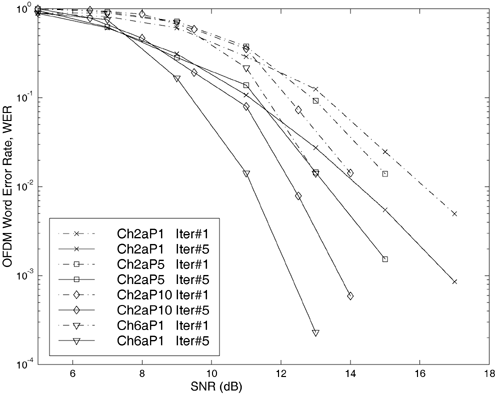 Finally, Fig. 10.29 also compares the performance of LDPC-based STC-OFDM systems with the same multipath delay profiles ( Ch2a ) but with different numbers of transmitter antennas ( N = 2 or N = 3). Since Ch2bN3 has a larger outage capacity than Ch2bN2 , it is seen that at medium to high SNRs, Ch2bN3 starts to perform better than Ch2bN2 with a steeper slope, which shows that the LDPC-based STC can be flexibly scaled according to a different number of transmitter antennas and can still improve the performance by exploiting the increased spatial diversity, especially at low WER (which is attractive in data communication applications). Performance with Unknown CSI In the following simulations, the receiver performance with unknown CSI is shown. The system transmits in a burst manner, as illustrated in Fig. 10.13. Each data burst includes 10 OFDM words ( q = 9, P = 1), the first OFDM word contains the pilot symbols, and the remaining nine OFDM words contain the information data symbols. Simulations are carried out in two-tap (two equal-power taps at 0 and 1 m s) frequency- and time-selective fading channels. The maximum Doppler frequency of the fading channels is 50 or 150 Hz (with normalized Doppler frequencies 0.015 and 0.044, respectively). Note that in Figs. 10.31 and 10.32, the energy consumption of transmitting pilot symbols is not taken into account in computing SNRs. The turbo receiver performance of a regular LDPC-based STC-OFDM system is shown in Fig. 10.31, whereas that of an irregular LDPC-based STC-OFDM system is shown in Fig. 10.32. (The average column weight in the parity-check matrix of the irregular LDPC code is 2.30.) TurboDD denotes the turbo receiver as before, except that the perfect CSI is replaced by the pilot/decision-directed channel estimates as proposed in [262], and TurboEM denotes the turbo receiver with the MAP-EM demodulator as proposed in Section 10.5.4. The temporal filter parameters are taken from [260]. The performance of these two receiver structures is compared when using either the regular LDPC codes or the irregular LDPC codes. From the simulations it is seen that with ideal CSI the receiver performance of regular and irregular LDPC-based STC-OFDM systems is quite similar. When CSI is not available, the proposed TurboEM receiver reduces the error floor significantly. Moreover, it is observed that by using the irregular LDPC codes, both the TurboDD and TurboEM receivers improve their performance, and the TurboEM receiver can even approach the receiver performance with ideal CSI in low to medium SNRs. A possible reason for the better performance of irregular LDPC-based STC than that of regular LDPC-based STC in the presence of nonideal CSI is the better performance of the irregular LDPC codes at low SNRs. In simulations, the turbo receiver takes three turbo iterations, and at each turbo iteration, the MAP-EM demodulator takes three EM iterations. At the cost of 10% pilot insertion and a modest complexity, the turbo receiver with the MAP-EM demodulator is a promising receiver technique, especially for application in fast-fading channels. Figure 10.31. Word-error rate of a regular LDPC-based STC-OFDM system with multiple antennas ( N = 2, M = 1) in two-tap ( L = 2) frequency-selective fading channels, without CSI. 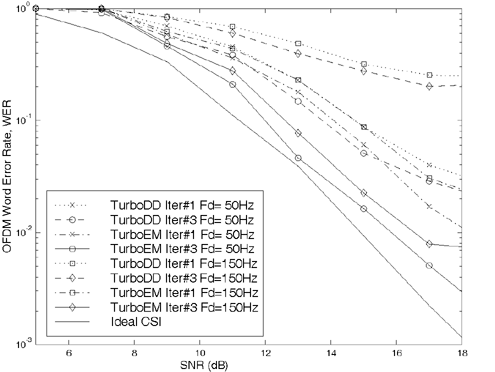 Figure 10.32. Word-error rate of an irregular LDPC-based STC-OFDM system with multiple antennas ( N = 2, M = 1) in two-tap ( L = 2) frequency-selective fading channels, without CSI. 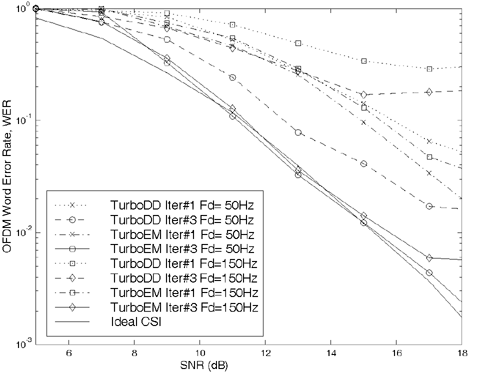  |





 [0,
[0, 





 , the highest achievable information rate converges to the ergodic capacity. [Note that the ergodic capacity is the area above each curve in the figure:
, the highest achievable information rate converges to the ergodic capacity. [Note that the ergodic capacity is the area above each curve in the figure: 





















